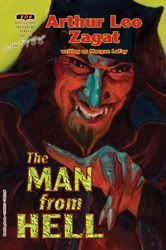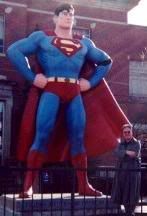| Pop Culture Gadabout | ||
|
Saturday, September 18, 2010 ( 9/18/2010 07:34:00 AM ) Bill S.  “ANOTHER DAY, ANOTHER SORCEROR TO HUNT.” Reading the second volume of Q Hayashida’s deliriously grisly “mature readers” horror comedy Dorohedoro (Viz Signature), I found myself concocting a word to describe this series’ unrepentantly bloody hi-jinx: splatstick. Set in a decaying urban hellhole where most of the residents have been randomly transmogrified by a group of masked evil sorcerers, Dorohedoro divides its storytime between human/lizard Caiman and his full-figured restaurateur gal pal Nikaido with a quartet of sorcerer “cleaners” sent to track down our twosome. Whether battling each other or making their way through the treacherous day-to-day, there’s always a dose of ultra-violence waiting in the alleyways. “ANOTHER DAY, ANOTHER SORCEROR TO HUNT.” Reading the second volume of Q Hayashida’s deliriously grisly “mature readers” horror comedy Dorohedoro (Viz Signature), I found myself concocting a word to describe this series’ unrepentantly bloody hi-jinx: splatstick. Set in a decaying urban hellhole where most of the residents have been randomly transmogrified by a group of masked evil sorcerers, Dorohedoro divides its storytime between human/lizard Caiman and his full-figured restaurateur gal pal Nikaido with a quartet of sorcerer “cleaners” sent to track down our twosome. Whether battling each other or making their way through the treacherous day-to-day, there’s always a dose of ultra-violence waiting in the alleyways.Thus, we see sorceress Ebisu, after getting her shredded face rejuvenated in the beginning of the volume, zombified in the midst of the Hole’s annual Night of the Living Dead. (“Goddamn it!” one of the other cleaners grouses, “I just fixed her up!”) Caiman, in a street fight with the aforementioned crew, has his head lopped, causing a massive geyser of blood with a face hiding in it to spurt from his neck -- though this only proves a temporary inconvenience. Nikaido, desperate to remove her friend to safety, is forced to bite off a fingertip: no blood this time, just a whiff of sorcerous smoke. Lots of outlandish action, in short, held together by mangaka Hayashida’s visually detailed scene setting and engaging character interactions. In the volume’s final entry, both our gal and her reptile bud take on a seemingly invincible Russian fighter for a million yen purse. The former enters the uneven contest because her best customer Caiman can never pay his tab; the latter does to rescue the overmatched Nikaido. Looking over Hayashida’s punky art style in this sequence, I couldn’t help mentally replaying the Ramones’ “The Crusher” as I raced through the fight scenes. I have no idea if the artist ever heard this track or not, though I still like to visualize her blasting Adios Amigos in her studio as she scratches out pen-work on this entertainingly outlandish manga series. (First published on Blogcritics.) Labels: sixty-minute manga # |Friday, September 17, 2010 ( 9/17/2010 06:28:00 PM ) Bill S. WEEKEND PET PIC: Another shot of our aged Aussie/Sheepdog blend, Ziggy Stardust:  THE USUAL NOTE: For more cool pics of companion animals, please check out Modulator's "Friday Ark." # | Tuesday, September 14, 2010 ( 9/14/2010 07:30:00 AM ) Bill S.  ”I GUESS YOU DON’T GO FOR PRO BONO WORK, HUH?” With the third volume of Saiko Takaki’s manga adaptation of Hideyuki Kikuchi’s Vampire Hunter D (DMP), fans of the long-running horror s-f series get to see how the manga artist handles an extra measure of melancholy. The story of a doomed romance, volume three (which has also been adapted into an anime feature) follows our dhampir bounty hunter as he and a nasty competing family of hunters (“They say no hunter who goes after the same noble as them lives to tell the tale.”) known as the Marcus Clan pursue a noble across the post-apocalyptic landscape. The vamp has seemingly kidnapped the daughter of a village elder, then left the village totally vampirized. Despite this, we’re told by D that of the nobility, only kidnapper Mayerling “has been praised by his subjects for his virtue.” ”I GUESS YOU DON’T GO FOR PRO BONO WORK, HUH?” With the third volume of Saiko Takaki’s manga adaptation of Hideyuki Kikuchi’s Vampire Hunter D (DMP), fans of the long-running horror s-f series get to see how the manga artist handles an extra measure of melancholy. The story of a doomed romance, volume three (which has also been adapted into an anime feature) follows our dhampir bounty hunter as he and a nasty competing family of hunters (“They say no hunter who goes after the same noble as them lives to tell the tale.”) known as the Marcus Clan pursue a noble across the post-apocalyptic landscape. The vamp has seemingly kidnapped the daughter of a village elder, then left the village totally vampirized. Despite this, we’re told by D that of the nobility, only kidnapper Mayerling “has been praised by his subjects for his virtue.”Adding to the complications: vampire Mayerling has hired the mercenary members of a neighboring village to protect him from his pursuers. Within this group is a creature very like the parasitic face on our hero’s left hand, only without as much attachment to the bodies it inhabits. It’s clear that D’s relationship to his own grotesque talking head is a unique one, but then D is not your “typical” dhampir. Where most of these human/vampire hybrids have to lie down in the dirt every six months or so, we’re told that D has gone for five years without succumbing to Sunlight Syndrome. Not so unique is the inevitable huge-breasted femme (does the “D” in this title really stand for our hero’s name -- or the heroines’ cup size?) falls for our lone wolf hero, though this part of the story has an added fillip by making the girl Leila a member of the incestuous Marcus family -- and D’s destruction of her creepy sibs her ultimate rescue. A few more s-f elements beyond our hero’s robotic steed crop up in this outing, as the fleeing noble, we learn late in the story, is heading for a spaceport in the futile hope of being able to escape the bonds of post-apocalyptic Earth. This anticipates the even stronger futureworld setting of the next book in the series, though it really appears to come out of nowhere in the manga. Perhaps the existence of the old spaceport was more clearly set up in the original novel? This small misstep aside, adapter and illustrator Takaki’s treatment of the material is smooth. Her deep-eyed art is especially strong when focusing on her star-crossed lovers, which is as it should be. Reading the third volume for the first time, I found myself thinking of what used to be called “adult westerns” back in the early days of network television: shows like Rawhide or Gunsmoke. They were called “adult” back in the day to differentiate them from the black hat/white hat dichotomies of kids’ westerns, though it’s not as if they were models of ultra-nuanced characterization. In the end, volume three deepens and darkens Kikuchi’s dystopian world but never loses sight of its place as a YA actioner. Which is also as it should be. (First published on Blogcritics.) Labels: sixty-minute manga # |Sunday, September 12, 2010 ( 9/12/2010 09:53:00 AM ) Bill S.  BEASTLETS AND BROOMSTICKS: In the annals of pulp fiction, the name Arthur Leo Zagat is not one that leaps to the top of the list. Yet the former lawyer turned fictioner was a prolific contributor to American fiction magazines of the thirties and forties, producing hundreds of yarns for mags like Argosy, Dime Mystery Magazine and Astounding Stories. Recently, Black Dog Books, a small press specializing in rescuing obscure works and writers from the glory days of the ten-cent story mags, released a collection of Zagat’s horror fiction entitled The Man from Hell. A definite curiosity, it won’t dislodged any of the big names from their place in the hierarchy, but it has its moments of cheesy fun. BEASTLETS AND BROOMSTICKS: In the annals of pulp fiction, the name Arthur Leo Zagat is not one that leaps to the top of the list. Yet the former lawyer turned fictioner was a prolific contributor to American fiction magazines of the thirties and forties, producing hundreds of yarns for mags like Argosy, Dime Mystery Magazine and Astounding Stories. Recently, Black Dog Books, a small press specializing in rescuing obscure works and writers from the glory days of the ten-cent story mags, released a collection of Zagat’s horror fiction entitled The Man from Hell. A definite curiosity, it won’t dislodged any of the big names from their place in the hierarchy, but it has its moments of cheesy fun.Seven of the nine stories in this collection were written under the gender-switched pseudonym of “Morgan LaFay” for one of the more intriguing pulp titles of the thirties, Spicy Mystery Stories. Befitting its title, Spicy specialized in terror tales that had a dose of sexiness to ‘em: heroines pressing “the firm roundness” of their breasts against manly heroes, fully hipped “pagan” sirens luring our heroes to their doom, between-the-paragraphs sex scenes -- nothing too explicit but hot stuff in its day to a young male readership. Because they were written for a mystery pulp rather than a straight-up horror title like Weird Tales, many of the LaFay stories have “logical” explanations for the seeming supernatural horrors that are described, though typically the writer’ll leave some room for the reader to ignore these killjoy rationalizations. Thus, in “Cargo for Hell,” the rageaholic captain of a cargo schooner takes his new bride with him on the cargo delivery of a coffin that his superstitious South Sea crewmen believe contains a vampire. The explanation proves more mundane, of course, but not before we’re treated to the sight of a slain crewman with a “throat whose lacerated sinews, whose slashed windpipe, were blanched, grey-white, bloodless.” As a prose-stylist, Zagat clearly showed a predilection for the purple. A few of the tales also display cultural attitudes a present day writer would have difficulty selling to most editors -- unless they dialed the Irony Meter up to the eleven. In “Hell’s Anteroom” and “The Sharp Teeth of Satan,” Zagat builds his horror on the fear of miscegenation: in the first, the marriage between a stalwart artist and a gypsy girl produces an animalistic “beastlet” of an offspring; in the second, a woman is debased by a sadistic “Eurasian mixed breed, than which there is no more devilish combination on God’s footstool.” The result of this union is a monstrous cretinous infant reminiscent of the killer baby in Larry Cohen’s schlock drive-in classic, It’s Alive. “Teeth” and other tale, “Her Demon Lover,” also contain elements of s-and-m for that extra dash of “spiciness.” In the second offering, a voluptuous country girl is whipped by her brutish moonshiner hubby for a page-and-a-half, tearing off her clothes and eliciting “exquisite agony” once it touches her breasts. You want lurid? We’ve got lurid. As a sampler of pulpy cheap thrills, The Man from Hell isn’t for the easily offended or those admirers of the exquisitely worded tale of terror. Rather, it’s for readers ready to dash through some cheap and disposable entertainment from a bygone era. If you’re the type of reader who knows and prefers the Spider to Doc Savage or the Shadow, who thinks that Seabury Quinn’s Jules de Grandin was every bit the equal to Sherlock Holmes -- if you even recognize all the names in the first half of this sentence -- than this book is for you. (First published on Blogcritics.) Labels: pulp fiction # | |
|
|

